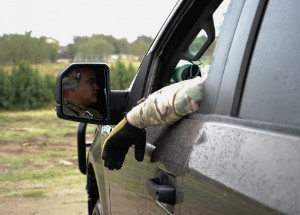Story and Photos by SSgt De'Jon Williams, 136th Airlift Wing, Texas Air National Guard
Army and Air National Guard members from various states stationed along the Southwest Texas border work together with their local, state and federal law enforcement partners.
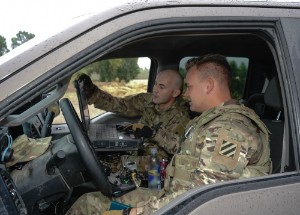 Cpl. Thomas Leroux and Spc. Joshua Smoak, a Task Force-Volunteer Mobile Video Surveillance System Truck team, view a computer screen in their Mobile Video Surveillance System truck Dec. 21, 2019 in Rio Grande City, Texas. The MVS truck cameras are displayed on computer screens inside the truck. (Air National Guard photo by Staff Sgt. De’Jon Williams)
Cpl. Thomas Leroux and Spc. Joshua Smoak, a Task Force-Volunteer Mobile Video Surveillance System Truck team, view a computer screen in their Mobile Video Surveillance System truck Dec. 21, 2019 in Rio Grande City, Texas. The MVS truck cameras are displayed on computer screens inside the truck. (Air National Guard photo by Staff Sgt. De’Jon Williams)
National Guard members provide support for a variety of tasks on behalf of the U.S. Border Patrol in an effort to allow more agents to protect our nation’s border directly in the field.
One way in which the National Guard assists Customs and Border Protection (CBP) is by surveilling illegal activity along the Rio Grande. Specialized trucks called Mobile Video Surveillance Systems (MVSS) give National Guard Soldiers and Airmen the capability to monitor a vast area of land along the border.
“Our job here is to be on the border in these trucks, observing the river and calling up what we see,” said Cpl. Thomas Leroux, an MVSS truck team commander.” The main objective is to deter any illegal activity between the United States and Mexico.”
MVSS truck commanders, or “TC’s” serve as the noncommissioned officer in charge of the site they are assigned to during a shift. They are also responsible for the maintaining of equipment used during operations.
“A big part of what I do is communicate with Border Patrol,” Leroux said. “I’m primarily responsible for the equipment and the relay of information.”
MVSS truck teams consist of the TC and a driver, who also serves as the equipment operator. Leroux is often partnered with Spc. Joshua Smoak, the driver for their team.
“Mainly my job is to get us from point A to point B without getting us stuck in the mud,” Smoak said. “I get us here, make sure we’re in a position where if anything does happen, we can get out safely and quickly. I also make sure I position the truck where the camera has the best visibility while also keeping it somewhat hidden.”
There are multiple teams of soldiers along the border using these trucks and other similar vehicles. For their team, Leroux and Smoak are using next generation scope trucks with night and day camera capabilities.
“On this truck, the main equipment is the cameras in the back,” Smoak said. “One is a normal camera, and the other is a heat signature camera. We can pull them up separately if we need to. They extend up about 30 feet, which is good to see over all the trees. We also use the laptop inside the truck, which is how we communicate with the cameras.”
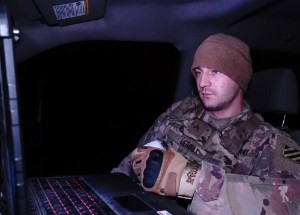 Cpl. Thomas Leroux, a Task Force-Volunteer Mobile Video Surveillance System truck commander, studies a computer screen in Rio Grande City, Texas, Dec 21, 2019. Leroux leads one of many two-man Mobile Video Surveillance System Truck teams along the Southwest Texas border. (Air National Guard photo by Staff Sgt. De’Jon Williams)
Cpl. Thomas Leroux, a Task Force-Volunteer Mobile Video Surveillance System truck commander, studies a computer screen in Rio Grande City, Texas, Dec 21, 2019. Leroux leads one of many two-man Mobile Video Surveillance System Truck teams along the Southwest Texas border. (Air National Guard photo by Staff Sgt. De’Jon Williams)
These trucks are assigned to each MVSS team at the beginning of their shift at various Border Patrol stations. The teams check out their trucks and begin their shift at the sites where they spend most of their shift.
“Once we get to the site, we do a transfer of authority (TOA),” Leroux said. “We do that with the group we are relieving. We transfer equipment, ammunition and paperwork. I complete the required paperwork and get accountability for the equipment. At the same time, I’ll discuss with the other group what happened on the previous shift.”
Leroux explains that during a TOA, the previous team transfers all the equipment and relays all the information from the prior shift. After this, the previous team is relieved, and the site is now his team’s responsibility.
In the meantime, the driver is also doing his part to participate in the TOA.
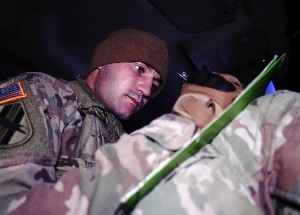 Spc. Thomas Leroux writes in his logbook Dec. 21, 2019 in Rio Grande City, Texas. Mobile Video Surveillance System teams keep a log of their findings while on duty. MVSS truck team leaders keep a log of their activities throughout their shift. (Air National Guard photo by Staff Sgt. De’Jon Williams)
Spc. Thomas Leroux writes in his logbook Dec. 21, 2019 in Rio Grande City, Texas. Mobile Video Surveillance System teams keep a log of their findings while on duty. MVSS truck team leaders keep a log of their activities throughout their shift. (Air National Guard photo by Staff Sgt. De’Jon Williams)
“When we first get here, my first job is to park the truck in a somewhat concealed position so that scouts on the other side can’t easily detect us,” Smoak said. “While he’s doing the TOA, my job is to get the equipment on the truck up and running.”
Smoak gets his camera and equipment up and running while the previous team continues to operate theirs. This protocol ensures that there is no gap in coverage of the area.
After the TOA is complete, Leroux and Smoak begin their shift monitoring the border.
“Throughout the day I keep the scan and surveillance going,” Smoak said. “Sometime there is action, sometimes there’s not, but it is how it is sometimes. At the end of the day the relief comes in and it’s the same process as before. I ensure continuous reconnaissance the entire time until the next team gets their scan up and going.”
Through technological prowess and Soldiers’ own vigilance, Leroux and Smoak have provided the Border Patrol with intelligence that has led to more than 90 apprehensions, 62 turn backs and a seizure of more than 235 pounds of narcotics since the beginning of the mission.
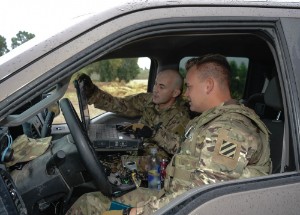 Cpl. Thomas Leroux and Spc. Joshua Smoak, a Task Force-Volunteer Mobile Video Surveillance System Truck team, view a computer screen in their Mobile Video Surveillance System truck Dec. 21, 2019 in Rio Grande City, Texas. The MVS truck cameras are displayed on computer screens inside the truck. (Air National Guard photo by Staff Sgt. De’Jon Williams)
Cpl. Thomas Leroux and Spc. Joshua Smoak, a Task Force-Volunteer Mobile Video Surveillance System Truck team, view a computer screen in their Mobile Video Surveillance System truck Dec. 21, 2019 in Rio Grande City, Texas. The MVS truck cameras are displayed on computer screens inside the truck. (Air National Guard photo by Staff Sgt. De’Jon Williams)
Of all the missions he supports, drug interdiction provides Leroux with the greatest fulfillment. Leroux said that participating in drug seizures is particularly rewarding for him because he “can physically see the fruits of [his] labor.” Particularly, Leroux was proud of “the feeling that I was a part of stopping that much of such a dangerous and harmful substance from making it into our country. I feel like we’re literally defending our nation.” Leroux then stated that for him, the mission has some elements which are personal: “I stopped drugs from getting within four blocks of a school, that’s huge! I have children and the idea that they would be in a place that is dangerous or subjected to that kind of environment is terrible. So, the idea that I’m able to prevent that is phenomenal! It’s great, I love it!”
This is the first time Leroux and Smoak have performed a mission like this, but it is one they both find rewarding.
“I had a lot of preconceptions before coming out here,” Smoak said. “There’s schools and kids and all this life right here… I’m just really happy that we’re able to help protect them [and] help secure this area so that they can live a normal, happy life. The safer the border is, the safer they can feel, the safer they can keep living their lives.”
